Pike Fish
Esox spp.
Advertisement
Pike Fish Scientific Classification
- Kingdom
- Animalia
- Phylum
- Chordata
- Class
- Actinopterygii
- Order
- Esociformes
- Family
- Esocidae
- Genus
- Esox
- Scientific Name
- Esox spp.
Read our Complete Guide to Classification of Animals.
Pike Fish Conservation Status
Pike Fish Facts
- Prey
- Mostly other fish, frogs, waterfowl
- Main Prey
- Fish, frogs, Insects
- Distinctive Feature
- Elongated body and strong jaw
- Optimum pH Level
- 6-8
- Habitat
- Slow moving water
View all of the Pike Fish images!
The largest northern pike specimen ever caught was a 55-pound fish that came from Lake Greffern, Germany in 1986.
The pike is a long-bodied and aggressive northern freshwater fish that lies in wait near the bottom of the water for its quarry to pass by so it can snatch them up in the blink of an eye. The term pike, which originated centuries ago before taxonomy was a true science, has sown quite a lot of confusion. All known pike fish belong to a single genus called Esox, but this genus also includes the closely related pickerel and the muskellunge. Together they make up a broad category of pike-like fish.
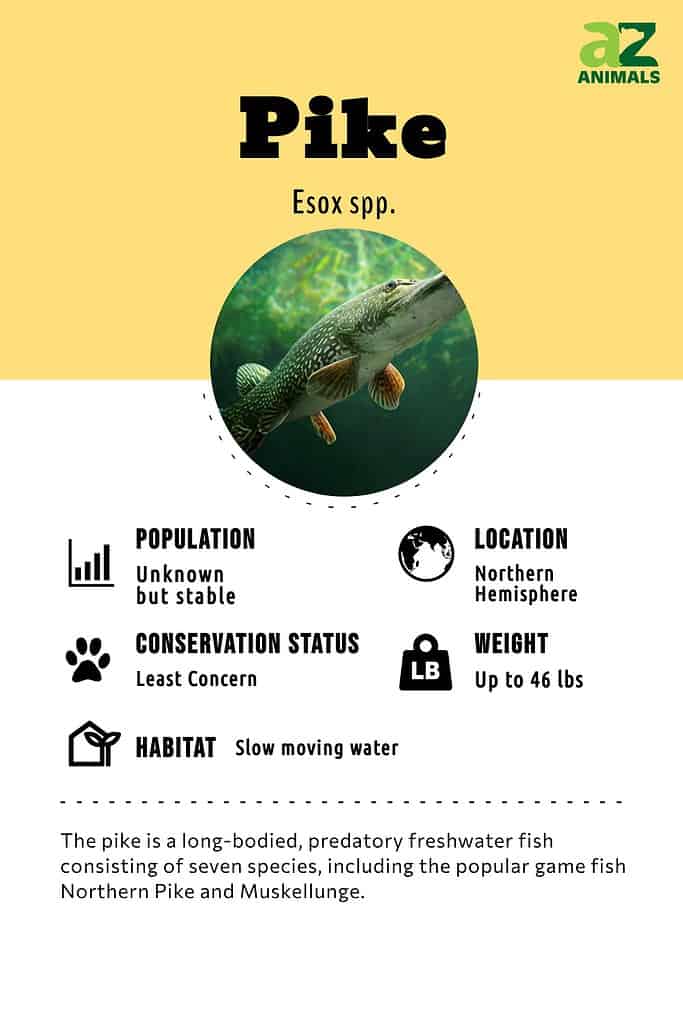
4 Amazing Pike Facts!
- The pike fish gets its name from the popular weapon used in combat, which consists of a pole with a metal instrument on top. This is probably due to the animal’s exceptional length.
- Pike fish have a mottled or spotted appearance with stripes on their back to provide camouflage among the vegetation at the bottom of rivers and lake beds. Like a fingerprint, these patterns are entirely unique to the individual.
- This is a solitary fish that largely sticks to its own devices except during the breeding season. This highly territorial creature will attempt to police its boundaries aggressively.
- Some species have a highly movable eye that can see in almost any direction.
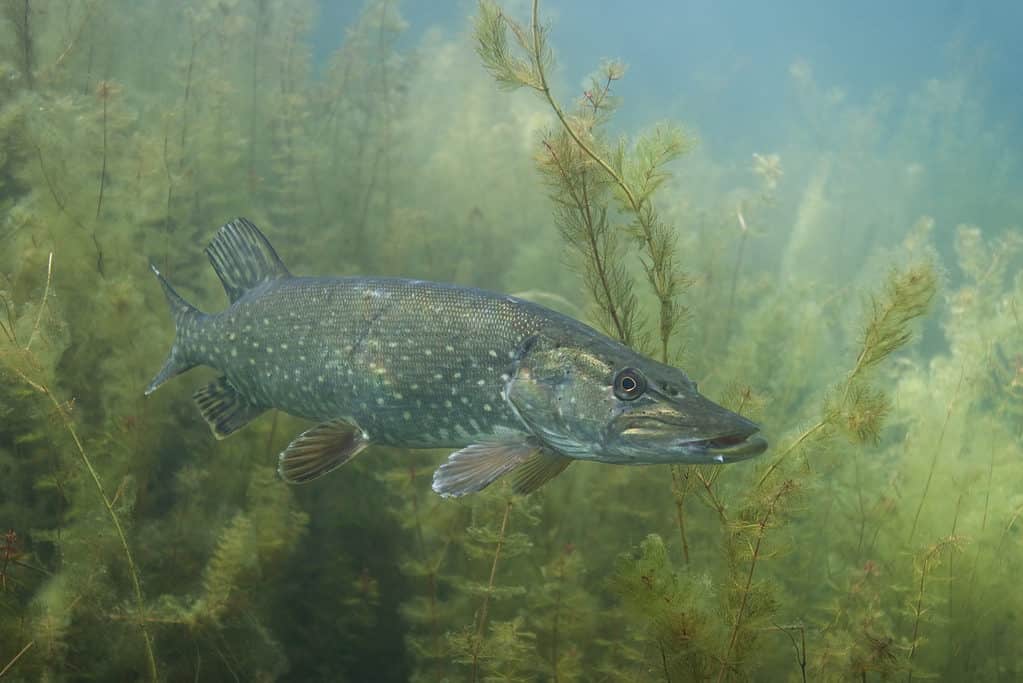
The pike’s mottled appearance allows it to hide among vegetation at the bottom of rivers and lakes.
©Martin Prochazkacz/Shutterstock.com
Scientific Name
The pike describes several species that belong to the genus of Esox (a Greek word likely borrowed from the Celtic term for certain types of long-bodied freshwater fish). This genus is the only currently living member of the family Esocidae. More broadly, it is part of the order Esociformes along with the small mud minnows. Several extinct types of pike have been found in the fossil record dating back tens of millions of years.
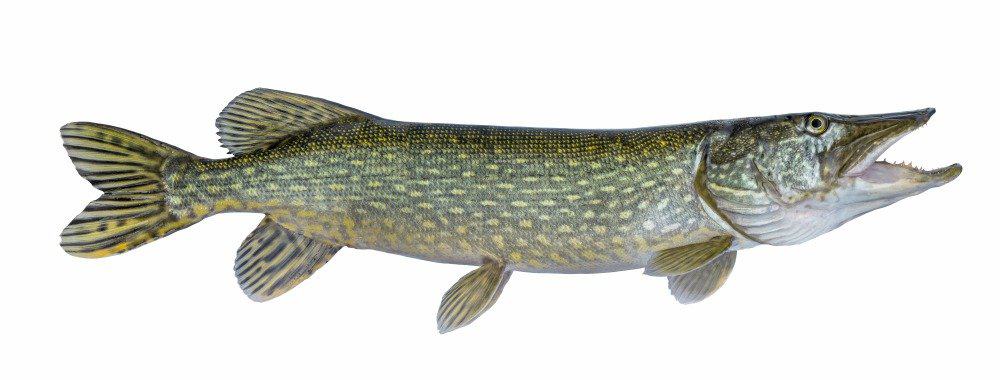
The pike belongs to the genus Esox.
©FedBul/Shutterstock.com
7 Types of Pikes
There are seven species currently recognized in the genus Esox. This includes four species officially called pike, plus the American pickerel, the chain pickerel, and the muskellunge. The seven species of Esox are:
- Northern Pike (Esox lucius): Endemic to Europe, Northern Asia, and North America (including a large stretch of territory between Alaska and the Midwestern United States), the northern pike is a very popular game fish. It was so popular, in fact, that people introduced it to other parts of the world, where it’s sometimes seen as a threat to native fishing stocks.
- Southern Pike (Esox cisalpinus): As the name suggests, this is the southern-most species of pike. It is found as far south as Italy, southern France, and Switzerland.
- Amur Pike (Esox reichertii): Also known as the black-spotted pike, it is native to the Amur River system in East Asia, which straddles China, Mongolia, and Russia.
- Aquitanian Pike (Esox aquitanicus): Native to the southwestern region of France, this species was first recognized in 2014, so not much is known about it.
- American pickerel (Esox americanus): This species is present in Canada and Mississippi, Florida, Michigan, Texas, and Mississippi.
- Chain pickerel (Esox niger): Known for putting up a fight when caught, these fish are found in the U.S. off the East Coast and parts of the Midwest and South. Other names for the fish are eastern pickerel and gunny.
- Muskellunge (Esox masquinongy): Commonly called the muskie, this large, predatory fish lives in freshwater lakes and rivers across North America and is thought of as a prized catch as it is difficult to land one.
The American pickerel has two subspecies:
- Redfin pickerel (Esox americanus americanus)
- Grass pickerel (Esox americanus vermiculatus).
The muskellunge has three subspecies:
- Great Lakes muskellunge (Esox masquinongy masquinongy): Also called spotted muskellunge
- Chautauqua muskellunge (Esox masquinongy ohioensis): Also known as barred muskellunge
- Clear muskellunge (Esox masquinongy immaculatus).
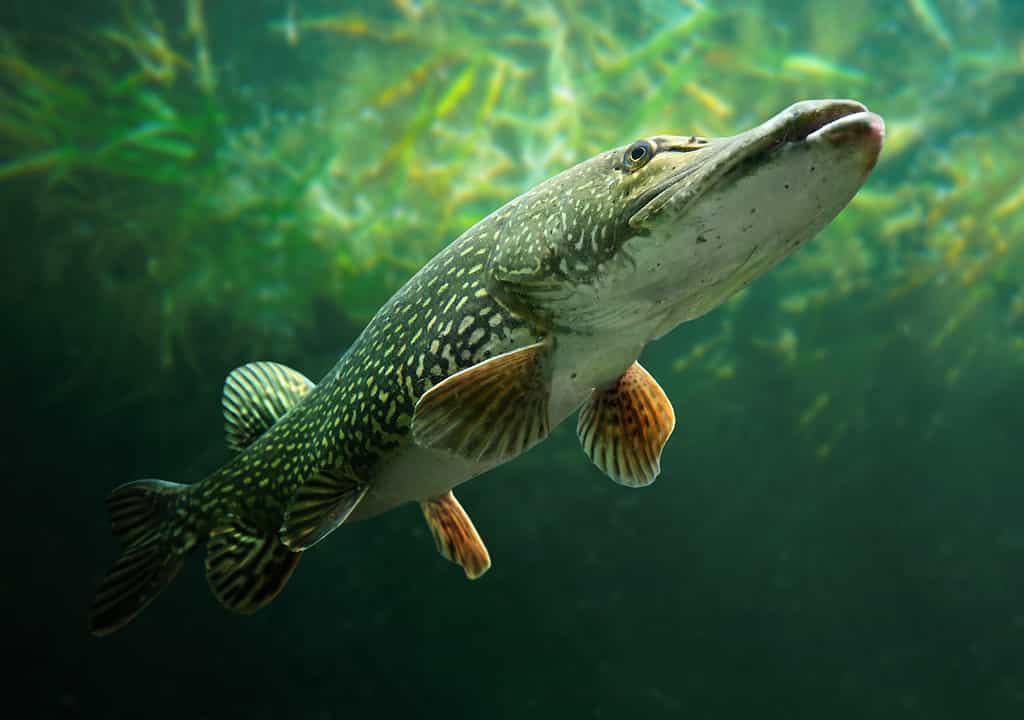
The northern pike is a popular game fish.
©iStock.com/abadonian
Evolution and Origins
The pike is a member of the Esocidae family of fish, which can be traced back as far as the Mesozoic era, between 66 million and 252 million years ago.
The genus Esox’s presence in North America and Eurasia dates to the Paleocene 66 million to 56 million years ago.
The earliest fossil evidence of Esox is Esox tiemani from the late Paleocene.
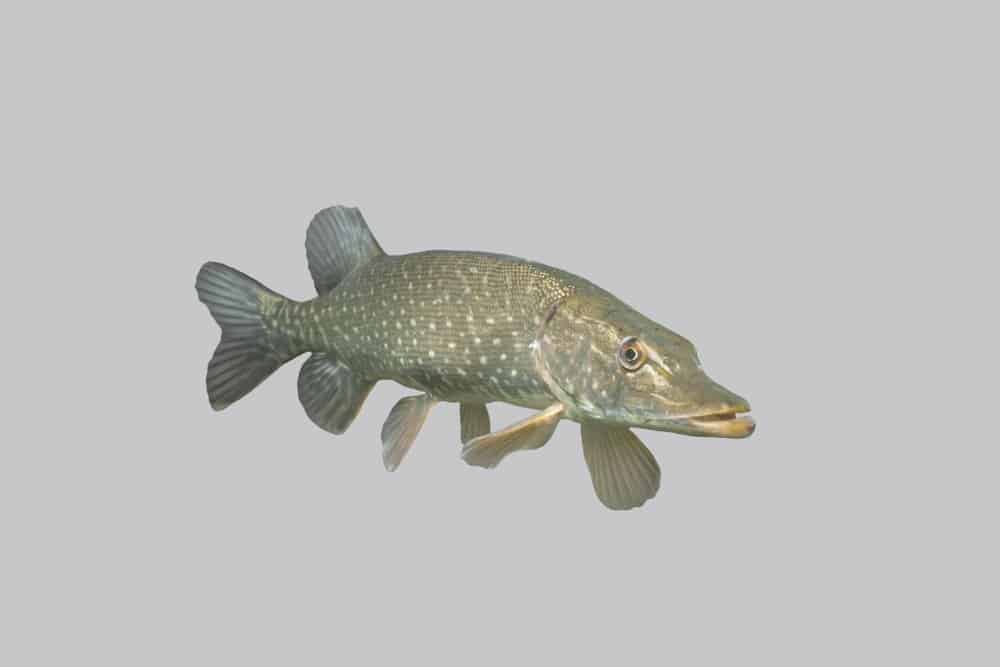
The pike is a member of the Esocidae family, which dates back to the Mesozoic era.
©CUTWORLD/Shutterstock.com
Appearance
The pike fish is characterized by a long, relatively flat body, a shovel-like mouth, and big teeth. It has a single dorsal and anal fin each near the tail, plus two pairs of fins near the head and stomach. The small scales are typically covered in blue-gray, yellow-green, or almost pinkish-red colors that become lighter near the underside of the fish.
The muskellunge is widely recognized as the largest member of the genus. The typical specimen in this species can reach up to 48 inches long and 36 pounds in weight (though specimens up to 70 pounds have been documented).
The more common northern pike averages 18 to 20 inches in length and can weigh up to 46 pounds, but it can also grow to much larger sizes. The largest recorded northern pike specimen ever caught was a 55-pound behemoth that came from Lake Greffern, Germany in 1986.

The pike has a long, relatively flat body and a shovel-like mouth.
©Kletr/Shutterstock.com
Habitat
The pike is found in freshwater rivers and lakes all over the Northern Hemisphere. The greatest concentration occurs in the United States and Canada. It can survive at all types of depths, including the bottom.
Diet
As an apex predator, the adult pike is a patient carnivore that lies in wait among the weeds for prey to come by so it can seize them with its sharp teeth in an aggressive display of rapid motion.
This animal prefers to consume insects, isopods, and small fish, while larger species also consume water birds, frogs, and small mammals. The northern pike is a cannibalistic fish that will feed on juvenile members of its own species.
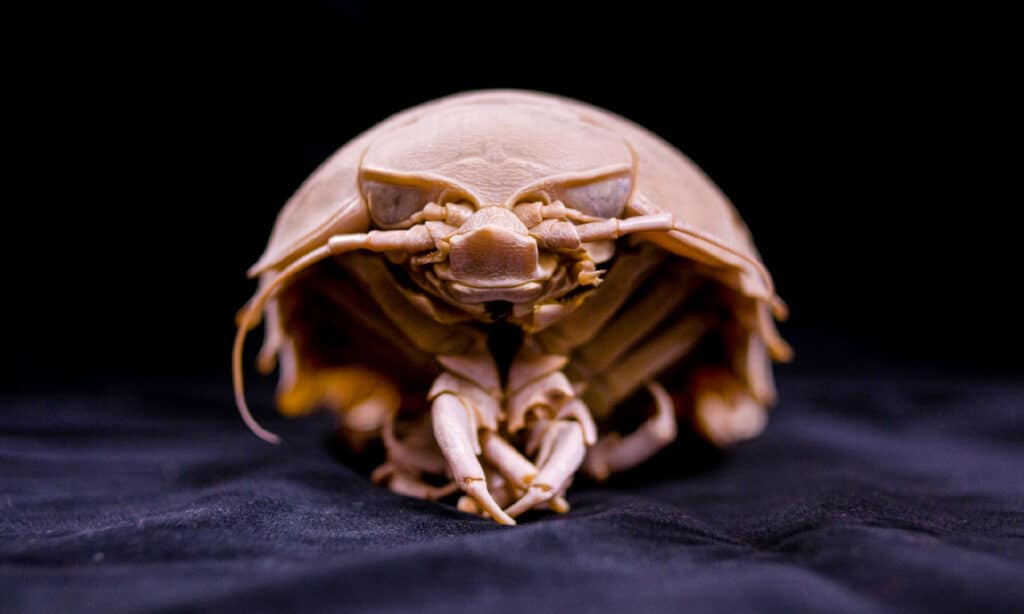
Isopods form part of the pike’s diet.
©iStock.com/LindaZ
Predators and Threats
The adult pike is a top predator in the food chain with few natural predators besides humans, but the eggs and juvenile fish do make a tasty snack for otters, aquatic birds, and other fish.

Otters feed on the pike’s eggs and young pikes.
©nvphoto/Shutterstock.com
Reproduction, Babies, and Lifespan
The pike’s spawning season usually occurs at any time between late winter and spring, when it begins moving upriver or closer to the shore. Mating behavior varies slightly by species. The male northern pike, for instance, can induce the female to release eggs by gently nudging her head. The male will then release his sperm to fertilize the eggs.
The young pike (sometimes called jacks) will emerge from the fertilized eggs a few weeks later. Vulnerable and alone, they will attach themselves to weeds and survive off the yolk sack while they still lack the ability to feed on more substantial food. When their mouths finally develop, the young fish will begin to consume zooplankton (tiny marine animals), and later on in its development, the fish will move on to larger prey.
A single female pike can produce thousands of eggs every year in the spawning season. Scientists believe that a female can lay 8,000 to 12,000 eggs per pound on average, so a fully grown fish weighing 20 to 40 pounds could lay between 200,000 and 400,000 eggs!
Many of these juveniles lack protection and are simply not expected to survive predation for the first few months. If it does develop into an adult, then the northern pike is known to live some 10 to 15 years in the wild. The longest documented lifespan is around 26 years.
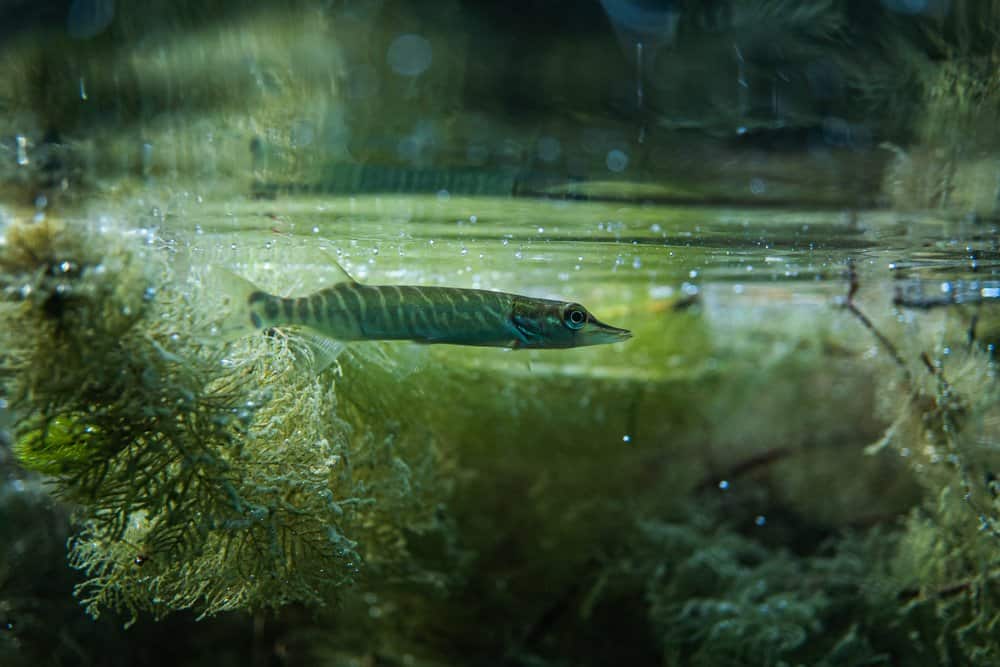
Juvenile pikes feed on zooplankton before they are big enough to catch larger prey.
©Lukas Kastner/Shutterstock.com
Population and Conservation
Despite frequent fishing by humans, this species as a whole is in stable and excellent health. Population estimates are unavailable.
The four species categorized by the IUCN Red List of the northern pike, chain pickerel, muskellunge, and redfin pickerel are of Least Concern.

The IUCN categorizes four species of pike as of Least Concern.
©Tobias Arhelger/Shutterstock.com
Pike in Fishing and Cooking
The pike is a popular fish in both recreational and commercial fishing. It is rarely caught in large enough quantities to cause excessive population pressures. It also does not adapt very well to artificial fisheries. Instead, it tends to be caught in smaller numbers by lone fishers. Dead bait, live bait, and lure fishing are all effective methods for catching the pike. However, due to the presence of its sharp teeth, extra care is required to handle the fish.
The pike has a white flakey flesh with a rather watery taste. Whether baked, grilled, or fried, the flesh is high in proteins and good fats. However, you should watch out for the small bones in the flesh that can really make this fish a nuisance to eat. You should clean it well before cooking.
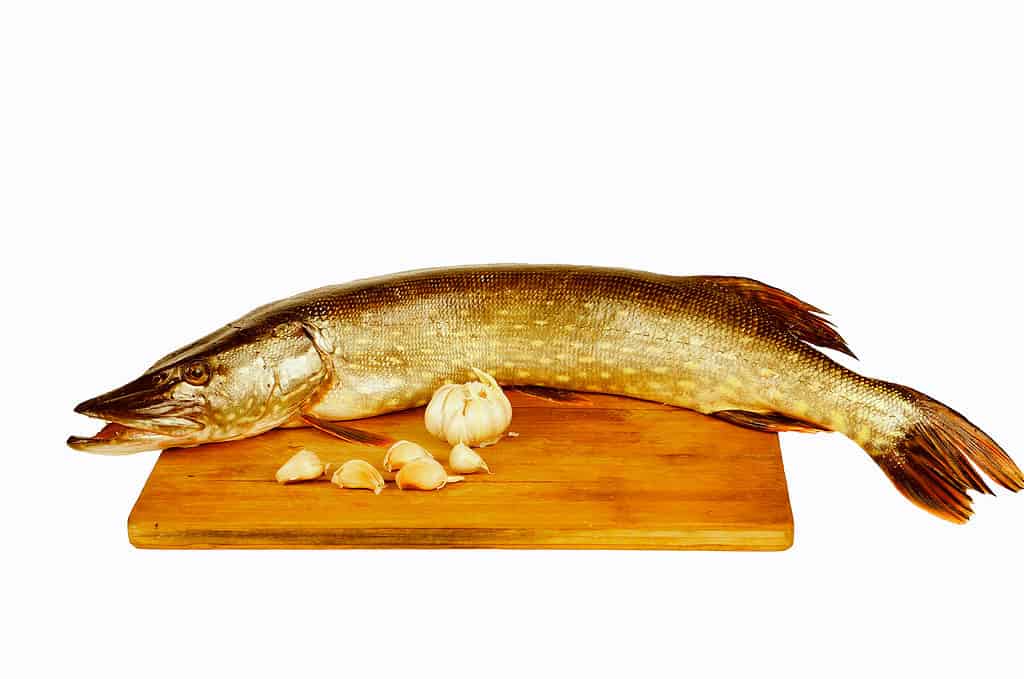
Pike is high in proteins and good fats.
©banosan/Shutterstock.com
Pike Fish FAQs (Frequently Asked Questions)
What is a pike?
Pike describes any member of the genus Esox. There are seven species in the genus, including the popular northern pike.
What does the pike look like?
The pike has a very long body, a shovel-like nose, and sharp teeth. The colors usually range between blue-gray, yellow-green, or pink-red, depending on the species.
Do pike attack humans?
Despite its aggressive nature, very few pike attacks on humans have ever been documented. That’s probably because the pike has no interest in tussling with a creature that’s much bigger than itself. The pike would prefer to run away in most cases.
Is pike healthy to eat?
Pike meat is high in proteins and healthy fats. It is a good source of heart-healthy omega-3 fats but not quite as much as some other cold water fish.
What states in the U.S. have pike fish?
The pike is endemic (or has been introduced) to most states in the country, but the greatest concentration of pike occurs east of the Rocky Mountains (and the Great Lakes region and northeastern states in particular). If you are interested in catching pike, then you should consult your local fish and wildlife departments for more information about the best spots.
Are pike herbivores, carnivores, or omnivores?
Pike are carnivores, meaning they eat other animals.
What kingdom do pike belong to?
Pike belong to the kingdom Animalia.
What phylum to pike belong to?
Pike belong to the phylum Chordata.
What family do pike belong to?
Pike belong to the family Esocidae.
What order do pike belong to?
Pike belong to the order Esociformes.
What genus do pike belong to?
Pike belong to the genus Esox.
What type of covering do pike have?
Pike are covered in small scales.
In what type of habitat do pike live?
Pike live in slow-moving water.
What is the main prey for pike?
Pike prey on fish, frogs, and insects.
What are some distinguishing features of pike?
Pike have elongated bodies and strong jaws.
How many babies do pike have?
The average number of babies a pike has is 100,000.
What is an interesting fact about pike?
Pike are an apex freshwater predator with fearsome teeth!
What is the scientific name for pike?
The scientific name for the pike is Esox.
What is the lifespan of a pike?
Pike can live for 12 to 15 years.
What is the optimal pH for pike?
The optimal pH for pike is between 6.0 and 8.0.
How do pike have babies?
Pike lay eggs.
Thank you for reading! Have some feedback for us? Contact the AZ Animals editorial team.


















